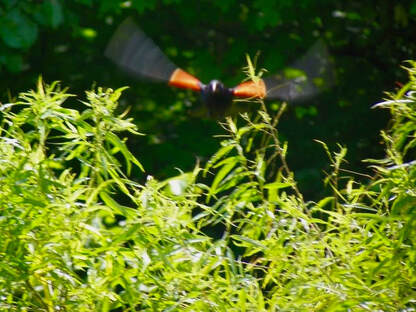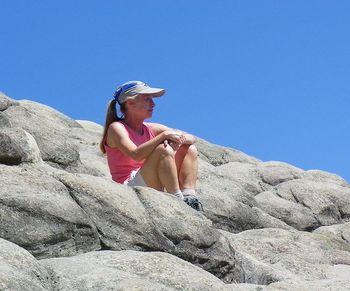 Birding might surprise you. A Red-Winged Blackbird in flight near Camp Last Resort, 2015. (Photo by Rick Showalter) Birding might surprise you. A Red-Winged Blackbird in flight near Camp Last Resort, 2015. (Photo by Rick Showalter) David Hoefer of Louisville, Ky., the co-editor of The Last Resort, offers an antidote for our trying times. The last several months have brought us the unsatisfying spectacle of a nation of 325 million people devising on-the-fly strategies to outwit a virus. Yes, there is a novel pathogen on the loose and, yes, certain groups, mostly the elderly and other persons with compromised immune systems, do appear to have a heightened risk of serious infection. What remains less clear is the actual extent of the threat to other segments of the population. The public-health response has evolved over time—remember gloves sí, masks no?—but one persistent feature has been the need to close up the populace indoors, away from others of our kind. This has proven problematic because modern humans—Homo sapiens—are profoundly social creatures. Efforts at selling “virtual communities” as replacements for flesh-and-blood gatherings are almost laughably off the mark. In reality, the antisocial practices of “social distancing” play to the worst aspects of American culture: the tendency to produce isolated individuals amusing themselves with trivial pursuits while failing at healthy, long-term relationships with family, friends, lovers, and neighbors. The longer we drag this out, the more likely unintended (and negative) consequences become. Be like PudOne sensible alternative to exile-at-home is the Great Outdoors. It’s becoming increasingly clear that fresh air and sunshine have been underutilized in our often-panicky response to COVID-19. Hiking, biking, picnicking, boating, fishing, and hunting are all good reasons for going outside, where the Earth’s ultimate limits remain hugely liberating, when compared to the four snug walls of our houses and apartments.
We used to understand that outdoor activities were beneficial for us. That was certainly the case for Pud Goodlett and the gang in The Last Resort. They went to the trouble of constructing a home-away-from-home, as a means of ready access to the varied and gracious Salt River environment of Anderson County, Kentucky. The cabin itself luxuriated in nature, with spiders, birds, weather, and even lightning intruding on occasion. This was no place to hide from the external world, calculating defenses against every potential risk to comfort and safety. Though Pud was a budding botanist, his journals make evident a sustained interest in the taxonomic class of Aves—our fine-feathered friends of the sky. Taken seriously, birding is an outdoor diversion of the very best sort, appealing about equally to the beauty-seeking soul and truth-hungry mind of anyone who engages in it. A great resource for beginning birders learning the ropes or lapsed veterans knocking off the rust is the Cornell Lab of Ornithology. Corny Orny, as I call it, offers online classes, extensive databases, and cutting-edge digital apps that can greatly enrich your birding experience. So be like Pud and light out for the world, even if it’s only your backyard or the local park. Our economy isn’t the only thing that’s been hurt by the corona shutdown. It’s time for us to get back to the business of being human.
14 Comments
Ed Lawrencr
7/14/2020 03:31:41 pm
I’ve been very lucky to have access to photograph in many private woods through the Woods and Waters Land Trust. This year has been my first sighting of such beauties as Scarlet Tanagers, Indigo Buntings and Baltimore Orioles. They seem more prevalent since Covid19 has limited human activity/pollution. Also, the clouds have been phenomenal to see. I don’t remember them being so big and beautiful. I feel lucky to be able to commune with nature in the woods or in my own backyard..
Reply
Ida
7/15/2020 05:51:08 pm
Another great outdoor activity is gardening! One can listen for birds while weeding!
Reply
Don Boes
7/16/2020 07:24:58 pm
A great description of a thoughtful and healthy way to appreciate nature! One of my best investments was to buy a simple bird feeder. It is always interesting to me to watch even the most common birds come and go. I also like to imagine birds as the possible descendants of dinosaurs--when I do that, every bird seems exotic.
Reply
Joe ford
7/16/2020 11:40:54 pm
Reply
Rogers Barde
7/17/2020 09:20:24 am
Thank you for the link. It's beautiful and filled with things to learn.
Reply
David Hoefer
7/17/2020 01:53:26 pm
Some great comments! Ida, you're right about gardening - don't know how I forgot that one. Birding and gardening go together like iced tea and sugar (or lemon). Joe, I'm pretty good on visual ID but much weaker on aural, which is what many of the big-time birders focus on. That's a future area of study. Rogers, I've done most of my digging out in New Mexico and the birding is indeed fantastic. I snuck a long list of sightings into my anthropology masters thesis, using environmental context as an excuse.
Reply
Rogers Barde
7/18/2020 10:07:53 am
Where were you digging? Do you know Pete McKenna, Tom Windes, Randy Morrison? Roger Moore? There are many more names that I can't think of right now. My husband dug at Sapawe in the 60's and was part of the survey of Chaco Canyon.
Reply
Don Boes
7/17/2020 04:58:39 pm
Hope is the Thing with Feathers by Christopher Cokinos
Reply
Sallie Showalter
7/17/2020 06:10:28 pm
What a fascinating read this must be! Thank you, Don, for sharing this.
Reply
David Hoefer
7/18/2020 04:32:19 pm
Rogers, it sounds like your husband was part of the Chaco Project group. I sing their praises all the time in my Chaco lecture, since they more or less established the benchmarks for Chaco interpretation. I don't know the individuals you mentioned though I know of them. (Windes was the PI at Pueblo Alto, I believe.) I did meet Steve Lekson at SAA a few years back. I've done much less important work at Ghost Ranch near Abiquiu. We've been working on a pair of Archaic Era rockshelters, GR-2 and GR-145, for many years. I should be there right now but COVID-19 has shut down the archaeology program. Big sigh.
Reply
David Hoefer
7/18/2020 04:37:22 pm
Rogers, I forgot to mention that your husband's Sapawe dig might have been conducted under Florence Hawley Ellis. Sapawe is located near the ranch. FHE founded the Ghost Ranch Archaeological Program after she retired from UNM. We started on Gallina sites in the mountains and switched to on-campus sites around 1990.
Reply
Rogers Barde
7/18/2020 05:33:50 pm
I remember Dr. Ellis well - my husband David Barde was a favorite of hers and he did several summers at Ghost Ranch under her - I was able to stay there with him in the tipis when he got back from Viet Nam and was in charge of a crew. It was a long time ago. Glad to hear about it from you.Good memories.
Reply
David Hoefer
7/19/2020 02:44:24 pm
I saw Sapawe in your previous comment, Rogers, and I figured that you likely knew FHE and maybe Ghost Ranch too. Do you remember Pat and Fred Trussell or John Hayden? Three GR old-timers. John is still around, crew chiefing at 145. As for the tipis, they tore those down a while back - too many uninvited rattlesnakes.
Reply
Your comment will be posted after it is approved.
Leave a Reply. |
Details
Archives
June 2023
Categories
All
|


 RSS Feed
RSS Feed